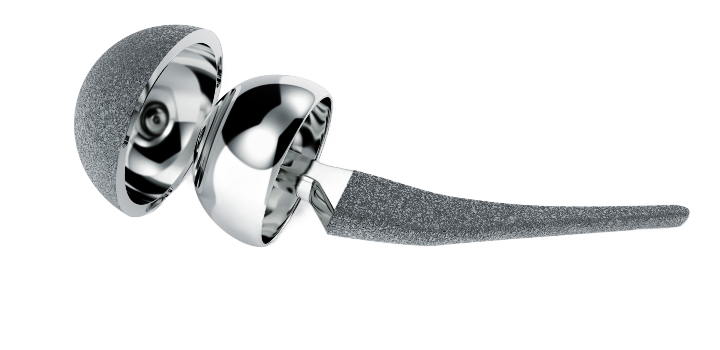
Hip implant
When it comes to orthopedic implants, careful and thorough surface preparation is vital for several reasons:
Biocompatibility: The interaction between the implant surface and the surrounding biological tissues is a critical factor in determining the success of the implantation. Surface preparation helps create an environment that promotes biocompatibility, ensuring that the implant integrates well with the patient's body without causing adverse reactions, inflammation, or rejection. By cleaning the surface and modifying its characteristics, surface preparation enhances the implant's ability to support tissue growth, promote osseointegration (in the case of bone implants), and minimize the risk of infections.
Tissue integration: The surface of an implant needs to facilitate the attachment and growth of surrounding tissues for long-term stability and functionality. Proper surface preparation can create a micro-roughened texture or specific surface features that promote cell adhesion and tissue integration. By modifying the surface topography, surface preparation enhances the implant's ability to bond with adjacent tissues, promoting the formation of a stable and functional interface.
Biocompatible blast medias: To further enhance the biocompatibility of dental and medical implants, It is possible to wet blast using biocompatible materials like HIMED's calcium-phosphates.
Corrosion resistance: Many medical implants are made from metallic materials that can be susceptible to corrosion in the body's physiological environment. Surface preparation techniques, such as passivation or coating application, help improve the implant's resistance to corrosion. By removing impurities, creating protective surface layers, or applying corrosion-resistant coatings, surface preparation enhances the longevity and performance of the implant while minimizing the risk of corrosion-related complications.
Infection prevention: Implant-associated infections are a significant concern in medical procedures. Surface preparation plays a vital role in removing contaminants, bacteria, and other microorganisms from the implant surface before implantation. Proper cleaning and sterilisation techniques help minimise the risk of introducing infectious agents into the patient's body, reducing the likelihood of post-operative infections.
Mechanical properties: Surface preparation can also influence the mechanical properties of the implant. For example, certain surface treatments can improve the hardness, wear resistance, or fatigue strength of the implant, ensuring its durability and long-term functionality. By modifying the surface characteristics, surface preparation can enhance the mechanical performance and reliability of the implant.
In summary, surface preparation of medical implants is important to ensure biocompatibility, tissue integration, corrosion resistance, infection prevention, and optimised mechanical properties. It plays a crucial role in improving the performance, longevity, and overall success of the implantation procedure.

Knee implant
Surface cleaning: Wet blasting effectively removes dirt, grease, oxide layers, and other contaminants from the surface of medical implants. By eliminating these impurities, the implant's surface can be prepared to achieve a cleaner and more hygienic state before subsequent treatments or coatings are applied. This cleanliness is essential to minimise the risk of infection and promote better integration with the patient's body.
Surface texture modification: Wet blasting can alter the surface texture of medical implants by controlled erosion of the material. This process creates a uniform and micro-roughened surface, which is desirable for improving the implant's biocompatibility. The modified surface can facilitate cell adhesion, enhance osseointegration (bone bonding), and promote the growth of soft tissue around the implant, leading to better long-term performance.
Removal of surface residues: Wet blasting can remove residual manufacturing contaminants, such as metal fines, machining fluids, or polishing compounds, from the surface of implants. These residues may adversely affect the biocompatibility of the implant, causing adverse reactions or inflammation in the patient's body. By eliminating such residues, wet blasting helps ensure that the implant surface is free from potentially harmful substances.
Creation of a uniform Surface Finish: Wet blasting can create a more uniform surface finish on medical implants, which is important for reducing localized stress concentrations and potential sites for corrosion. By removing surface irregularities, burrs, or sharp edges, wet blasting helps to eliminate potential sources of tissue irritation, minimising the risk of adverse reactions or complications after implantation.
Preparation of surfaces for coating: Wet blasting produces a highly reactive surface that is perfect for maximum coating adhesion performance and bonding.
Peening surfaces for strength: Wet blasting surfaces can help to eliminate known areas of weakness by peening the implant’s surface. It does this by converting tensile into compressive stresses, which in turn improves the durability and longevity of the implant.
Peening implant coatings for durability: The peening effect of wet blasting can also be applied to coatings. Once the coating’s been applied wet blasting can convert tensile stresses in the coating to compressive stresses, dramatically improving the durability and longevity of the coating.
Removal of un-sintered and partially sintered powder from additive-manufactured implants: An increasing number of implants are produced by additive manufacturing. This type of manufacturing allows for highly complex structures that combine strength and lightweight, structures that are not possible to produce by conventional production methods. Wet blasting is highly effective at removing sintered and partially sintered powder from the complex structures of additive-manufactured implants.
It's important to note that wet blasting alone may not guarantee optimal biocompatibility of medical implants. The specific material composition, design, and subsequent processing steps, such as sterilisation or applying bioactive coatings, also play critical roles in determining the biocompatibility and overall performance of the implant. Wet blasting should be considered as part of a broader manufacturing and surface treatment strategy to improve the biocompatibility of medical implants.